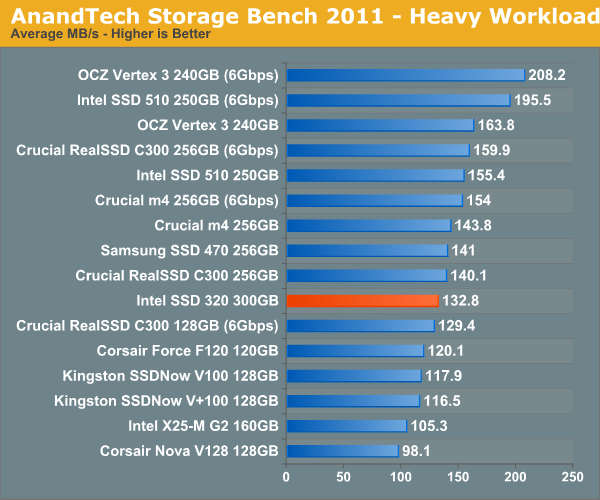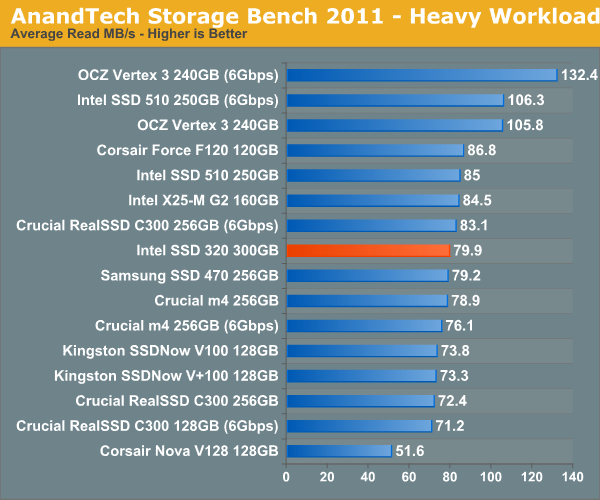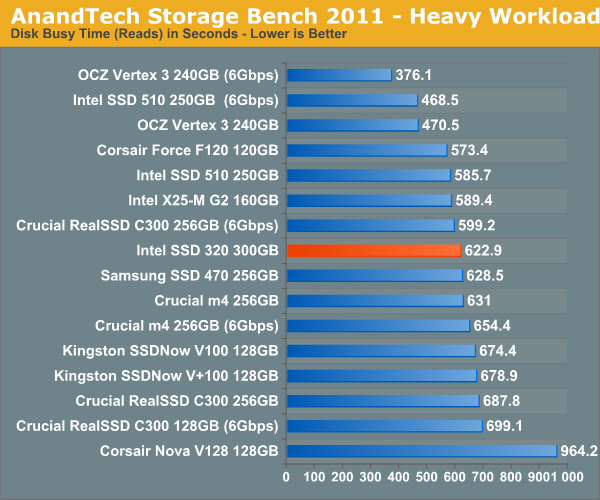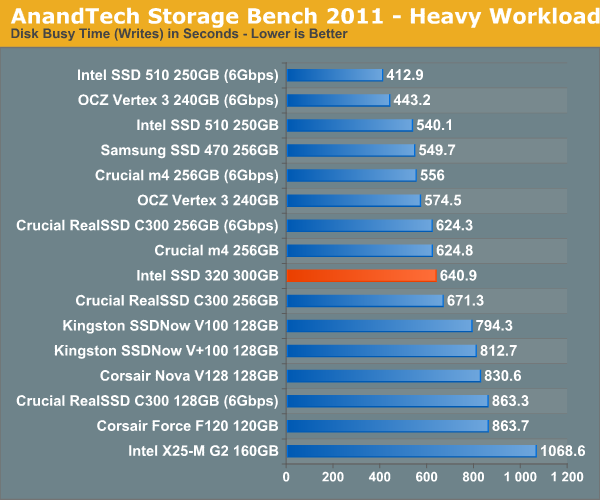The Intel SSD 320 Review: 25nm G3 is Finally Here
by Anand Lal Shimpi on March 28, 2011 11:08 AM EST- Posted in
- IT Computing
- Storage
- SSDs
- Intel
- Intel SSD 320
AnandTech Storage Bench 2011: Much Heavier
I didn't expect to have to debut this so soon, but I've been working on updated benchmarks for 2011. Last year we introduced our AnandTech Storage Bench, a suite of benchmarks that took traces of real OS/application usage and played them back in a repeatable manner. I assembled the traces myself out of frustration with the majority of what we have today in terms of SSD benchmarks.
Although the AnandTech Storage Bench tests did a good job of characterizing SSD performance, they weren't stressful enough. All of the tests performed less than 10GB of reads/writes and typically involved only 4GB of writes specifically. That's not even enough exceed the spare area on most SSDs. Most canned SSD benchmarks don't even come close to writing a single gigabyte of data, but that doesn't mean that simply writing 4GB is acceptable.
Originally I kept the benchmarks short enough that they wouldn't be a burden to run (~30 minutes) but long enough that they were representative of what a power user might do with their system.
Not too long ago I tweeted that I had created what I referred to as the Mother of All SSD Benchmarks (MOASB). Rather than only writing 4GB of data to the drive, this benchmark writes 106.32GB. It's the load you'd put on a drive after nearly two weeks of constant usage. And it takes a *long* time to run.
I'll be sharing the full details of the benchmark in some upcoming SSD articles but here are some details:
1) The MOASB, officially called AnandTech Storage Bench 2011 - Heavy Workload, mainly focuses on the times when your I/O activity is the highest. There is a lot of downloading and application installing that happens during the course of this test. My thinking was that it's during application installs, file copies, downloading and multitasking with all of this that you can really notice performance differences between drives.
2) I tried to cover as many bases as possible with the software I incorporated into this test. There's a lot of photo editing in Photoshop, HTML editing in Dreamweaver, web browsing, game playing/level loading (Starcraft II & WoW are both a part of the test) as well as general use stuff (application installing, virus scanning). I included a large amount of email downloading, document creation and editing as well. To top it all off I even use Visual Studio 2008 to build Chromium during the test.
Many of you have asked for a better way to really characterize performance. Simply looking at IOPS doesn't really say much. As a result I'm going to be presenting Storage Bench 2011 data in a slightly different way. We'll have performance represented as Average MB/s, with higher numbers being better. At the same time I'll be reporting how long the SSD was busy while running this test. These disk busy graphs will show you exactly how much time was shaved off by using a faster drive vs. a slower one during the course of this test. Finally, I will also break out performance into reads, writes and combined. The reason I do this is to help balance out the fact that this test is unusually write intensive, which can often hide the benefits of a drive with good read performance.
There's also a new light workload for 2011. This is a far more reasonable, typical every day use case benchmark. Lots of web browsing, photo editing (but with a greater focus on photo consumption), video playback as well as some application installs and gaming. This test isn't nearly as write intensive as the MOASB but it's still multiple times more write intensive than what we were running last year.
As always I don't believe that these two benchmarks alone are enough to characterize the performance of a drive, but hopefully along with the rest of our tests they will help provide a better idea.
The testbed for Storage Bench 2011 has changed as well. We're now using a Sandy Bridge platform with full 6Gbps support for these tests. All of the older tests are still run on our X58 platform.
AnandTech Storage Bench 2011 - Heavy Workload
We'll start out by looking at average data rate throughout our new heavy workload test:

Overall performance is decidedly last generation. The 320 is within striking distance of the 510 but is slower overall in our heavy workload test.
The breakdown of reads vs. writes tells us more of what's going on:


The next three charts just represent the same data, but in a different manner. Instead of looking at average data rate, we're looking at how long the disk was busy for during this entire test. Note that disk busy time excludes any and all idles, this is just how long the SSD was busy doing something:













194 Comments
View All Comments
Chloiber - Tuesday, March 29, 2011 - link
True.It is true, thet the REAL capacity of flash drives is 2 based. The NAND chips are.
So a 120GB drive has in reality 128GB of flash.
So its 120/128 % spare area. The 300GB version has also 300/320 % spare area (which is exactly the same).
Anand is confusing things. The user gets 300GB, as he gets 300GB when buying a HDD. Windows on the other han is showing us "GiB" not "GB". But it's not a real difference in size. 74.5GiB EQUALS 80GB. It's the same thing. Compare the BYTE numbers if you wanna be sure, not the KB/MB/GB/TB numbers.
I'm actually shocked that this still gets confused.
overzealot - Tuesday, March 29, 2011 - link
RAM was not the only thing that was calculated using binary pseudo-metric prefixes. Perhaps you aren't old enough to remember the days before kibibytes, when all computer disks and tapes were measured as such.noblemo - Wednesday, April 6, 2011 - link
Conversion from GB to GiB:320 / 1.024^3 = 298 GiB
Subtract 6.25% spare area:
298 x (1-0.0625) = 279 GiB
MeanBruce - Monday, March 28, 2011 - link
You can blather all the technostats you want 25nm, who cares, didn't change a thing! My next ssd, would never have said this a year ago, looks like Corsair Force GT! Read/Write 500/500 is all you need to say!;)zanon - Monday, March 28, 2011 - link
Granted, this isn't a stunning offering. But one thing I do look forward to is that I think we will finally start to see updated filesystems start to appear in the near future. For example, ZFS appears as if it will at last appear as a full Mac OS X file system via Z-410 this summer.One of the features of modern filesystems is full filesystem level compression and encryption (which really is where such features belong). I will be looking forward to (hopefully) seeing you test how this affects the SSD scene. My principle concern with Sandforce's strategy in the back of my head has always been this: that sooner or later, OS makers or someone will finally get with it and make full compression standard in the FS. At that point, the "worst case" scenario of fully random data will become the *only* scenario. That still leaves a (huge huge) legacy market, and likely time to adapt, but I do wonder if it will shake up the SSD scene at all once again.
overzealot - Tuesday, March 29, 2011 - link
I don't agree. If the controllers are powerful enough to do encryption and compression in real-time, then it should still be done at the disk level.You can still encrypt/compress in your OS as you please, but I like having performance.
PS, not dogging on ZFS, I use it all the time with openindiana.
marc1000 - Monday, March 28, 2011 - link
vertex 3 is not already on market???http://www.amazon.com/OCZ-Technology-Vertex-2-5-In...
aork - Monday, March 28, 2011 - link
That's for pre-order. Notice "Usually ships within 1 to 2 months."piquadrat - Monday, March 28, 2011 - link
Is it sufficient, security wise, using only max. 8 characters ATA password against thieves?One program, I sometimes use, MHDD offers ATA password reset option.
If someone can bypass ATA pass so easily what all this AES128 is for?
Could someone explain this matter to me?
DesktopMan - Monday, March 28, 2011 - link
The password is used to generate the encryption key, much like how software products such as TrueCrypt does it.The max length of ata paswords is 32 which should be more bits than the actual key, depending on character set. 8 is not much though, depending on how these drives deal with brute force attacks.
Old drives with ata passwords are just enabled with the password, which can be circumvented with master passwords or firmware commands in some cases.